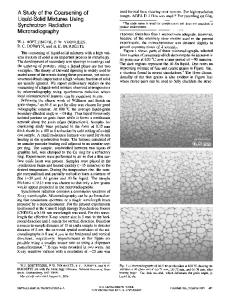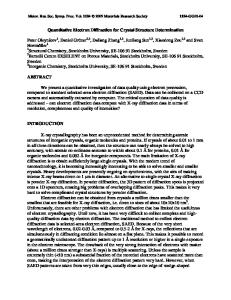Study of the crystal device for deflecting high-energy proton beams using synchrotron radiation diffraction
- PDF / 596,933 Bytes
- 4 Pages / 612 x 792 pts (letter) Page_size
- 79 Downloads / 319 Views
RACTION AND SCATTERING OF IONIZING RADIATIONS
Study of the Crystal Device for Deflecting High-Energy Proton Beams Using Synchrotron Radiation Diffraction A. A. Kaloyana, S. A. Tikhomirova, K. M. Poduretsa,*, V. A. Maisheevb, Yu. E. Sandomirskiyb, and Yu. A. Chesnokovb b
a National
Research Centre “Kurchatov Institute,” Moscow, 123182 Russia Institute for High Energy Physics, National Research Centre “Kurchatov Institute,” Protvino, Moscow oblast, 142281 Russia *e-mail: [email protected] Received November 26, 2015
Abstract—Currently, bent silicon single crystals are used at large accelerators to extract and collimate proton beams. A device for multiple deflection of a proton beam based on several bent silicon strips operating in the volume reflection mode has recently been developed. In this device, the bending of silicon strips successively located on the surface of a thick plate is implemented due to the internal stress induced by grooves mechanically formed on the crystal surface (Twyman effect). Topography based on angular scanning and synchrotron radiation was applied to measure the bending of individual deflector strips and the crystal as a whole. The measurement results are compared with the data obtained with a proton beam. DOI: 10.1134/S1063774517030099
INTRODUCTION The range of application of bent crystals (characterized by high strengths of internal electric fields—on the order of 108 V/cm) for extracting and collimating high-energy proton beams in large ring accelerators constantly increases [1–6]. These crystals have been used basically in the planar channeling mode. Recently a new physical phenomenon—reflection of a high-energy proton beam from bent atomic planes of silicon crystal—was experimentally discovered, and studies aimed at implementing this effect in accelerators were started [7–10]. The effect of volume reflection is caused by the interaction of an incident proton with the potential of bent atomic lattice; it occurs on a small length of a path tangent to a bent atomic plane. The deviation angle of the particles reflected from crystallographic planes is limited by a value of 1.5θc, where θc = (2Uc/pv )1/2 is the critical angle of channeling; Uc ~ 20 eV is the potential-barrier height for the channel in Si(111) plane; and p and v are, respectively, the momentum and velocity of the incident particle. To increase the reflection angle and apply in practice the effect of volume reflection for extraction and collimation of beams, it is necessary to increase the deviation angle of charged particles. Multicrystal devices, consisting of several individual bent crystals, were proposed and tested on high-energy (several GeV) particle beams in [11–14].
A new bending scheme was recently proposed in [16] to design and apply this device at the Large Hadron Collider (LHC) [15] at energy of 7 TeV. In this scheme, the bending is caused by the internal stress induced by grooves mechanically formed on the surface of a thick crystal (Fig. 1a) rather than by an external force exerted by the holder. The bendin
Data Loading...










